The Sunshine State of Florida is home to 196 Avian species and for fans of birds of prey, you’ll be happy to know that Florida is the full or part-time home to 20 species of this variety. Today we’ll take a closer look at them so that you’ll know how to identify them, what they like to eat, where they spend their time, and we’ll throw in a few fun facts as well.
Let’s take a closer look at the Florida Birds of Prey!
American Kestrel – Falco sparverius

Coloration and Markings: American Kestrels have rust-brown backs with black spots, which extended to the inner edge of their long, narrow wings, with the wing coloration changing to a black-spotted slate blue for the remaining majority of the wings. Seen in flight the arrangement of spots is more symmetrical and looks a bit like an optical illusion. Kestrels have long, square-tipped tails and the belly of this bird is white. The breast will be white with some rust coloration missed at the upper breast and facially, the chin and cheeks are white with a pair of vertical black slashes present, while the back of the head will be rust colored with a black stripe at the back-center. Above the eyes, a wide gray stripe is present, and you will see a rust-colored cap. These birds have small, curved orange and gray bills and female Kestrels will have rust colored wings, rather than slate.
Size: These birds measure in at 8.7 – 12.2 inches in length and have wingspans of 20.1 to 24 inches in width.
Habitat: These birds hunt in a wide range of areas, such as alpine regions, grasslands, and deserts. They tend to prefer open areas with fewer trees to maximize their hunting success.
Diet: Insect-wise, these birds love grasshoppers, beetles, and moths, but they also take small mammals like mice or bats and birds of up to quail-sized!
More about the American Kestrel
Found all over Florida, the American Kestrel is the smallest species of Falcon in North America. They have a lifespan of about 17 years in captivity, but only 5 in the wild. They are attracted to nesting boxes, so you can put one out if you have noticed some local Kestrels and you might tempt a breeding pair into moving in. One spotting tip is if you are at a sporting event at night, look near the lights. Kestrels are known to perch nearby so that they can look for and capture moths that are attracted to the bright lights. Kestrels also store food for lean times. They’ve been known to take extra kills that they can’t eat right away and to store them in tree limbs, cavities, and even fence posts!
Bald Eagle – Haliaeetus leucocephalus
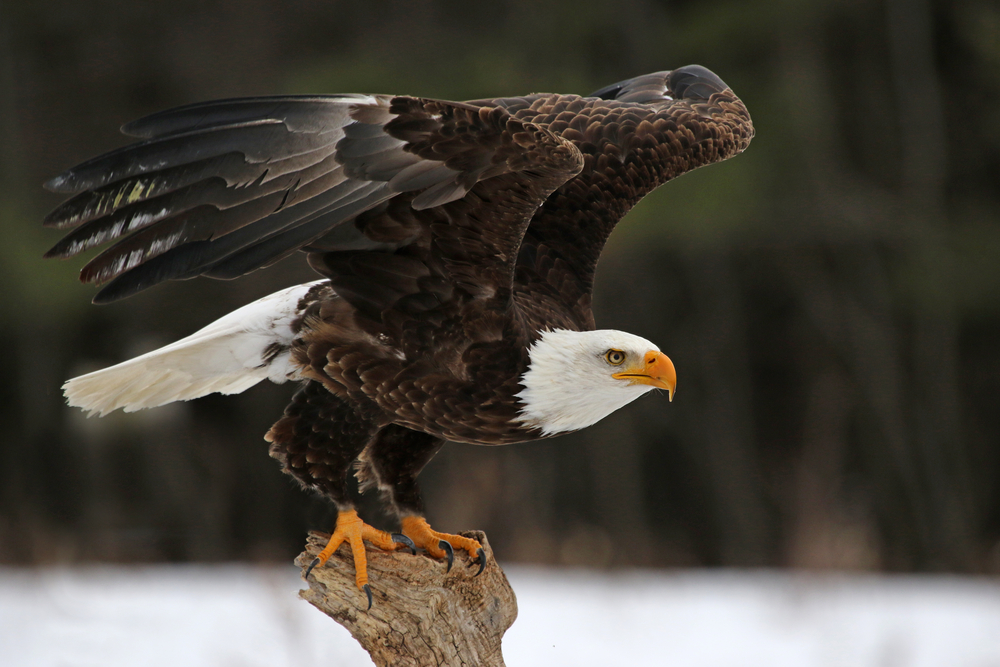
Coloration and Markings: Bald Eagles have dark brown backs with long wings of the same color and short tails which are brown on top and white below. The belly and breast of this bird are dark brown as well but facially, these birds are white, with the coloration coming down to their throats and the back of their heads rather like a mane. These birds have large, hooked yellow bills. Juveniles will have mostly brown coloration with scattered patches of white, which dwindle as the bird matures.
Size: One of the largest birds in North America, these Eagles measure in at 27.9 – 37.8 inches in length and have wingspans approximately 80.3 inches wide.
Habitat: These birds like to be near water, so look for them around the coast, lakes, marshes, and rivers.
Diet: Bald Eagles primarily eat fish, but they will also catch and eat smaller birds such as waterfowl and small mammals, primarily squirrels, rabbits, prairies dogs, and even the occasional kitten! They are opportunistic predators as well, which means they will bully other birds to steal their kills.
More about the Bald Eagle
The Bald Eagle is the national bird of the United States of America and if you’ve ever seen one in person you can definitely see why. Large and fierce, these powerful birds have a lifespan of approximately 20 years and may be found all over Florida near lakes, rivers, and coasts. Bald Eagles are great at catching fish but sometimes prefer to simply snatch them away from the claws of other fishing birds, such as Ospreys. They’ve even been known to steal fish from human fishermen! While they are indeed apex predators, Bald Eagles do have a playful side. They’ve been observed passing wooden sticks in the air with other Eagles and they’ve been seen to be playing with plastic bottles from time to time. Aside from playing together, these birds will occasionally hunt together as well, with one Eagle driving prey towards the other so that it may be killed and shared by both.
Barred Owl – Strix varia

Coloration and Markings: Barred Owls have mottled brown and white backs, with large wings and short, rounded tails which display brown barring on white, though the undersides of the tails will be white-tipped. The belly and breast of this bird are white with vertical brown bars and facially, these owls have rounded heads with no ear tufts displayed and the face is a mix of brown and white that looks almost grayish, with two white half-eyebrows and a white figure-8 shape framing the eyes and the cheeks. These birds have small, stout, curved yellow bills.
Size: These owls measure in at 16.9 – 19.7 inches in length and have wingspans of 39 – 43 inches wide.
Habitat: These birds prefer evergreen and deciduous woods, but they are sometimes seen in coniferous woods a well. They like to nestle in tree cavities during the day.
Diet: The owls like to eat mice, squirrels, snakes, frogs, lizards, and even the occasional crab or fish if they can catch them.
More about the Barred Owl
Found throughout Florida, the Barred Owl has a lifespan of about 10 years in the wild and 20 years in captivity. Usually found near bodies of water, these birds are sometimes active during the day and they have a very distinctive call which sounds like ‘who cooks for you? Who cooks for you all?”. The Owls are non-migratory and this was confirmed with a study where 158 of them were tagged and by the end of the study, none of them had relocated more than a distance of 6 miles. If you are out birding and lucky you can spot a juvenile climbing up a tree, which they do by grasping the bark in their powerful bills and flapping their wings and sinking their talons into the wood, allowing them to ‘walk’ up the tree. It’s definitely a sight to behold.
Black Vulture – Coragyps atratus

Coloration and Markings: Black Vultures are almost completely black, with the exception of the underside of their wings where white patches at the tips, called ‘stars’ are present and highly visible. Their wings are long, broad, and rounded, while their tails are short but also rounded. Facially, their skin id black and bare, and these birds have long, narrow bills with a noticeable hook.
Size: These birds measure in at 23.6 – 26.8 inches and have a wingspan of 53.9 to 59.1 inches wide.
Habitat: Black Vultures love open, wooded areas, which they soar above while searching for their next meals.
Diet: While they mostly eat carrion, these birds also steal eggs from other birds, as well as lizards and turtles. They may occasionally catch and eat small birds and sea turtles or newborn mammals, if they can catch them.
More about the Black Vulture
Black Vultures are quite striking, being almost completely black except for the white stars at their wingtips. They have a lifespan of about 10 years in the wild, on average, though the oldest tagged specimen was recorded to have lived 25 years and 6 months. If you’ve ever been near one of their nests, it’s a smell that you will never forget, having once been described as ‘the smell of 1000 corpses’. Yes, carrion is the biggest part of their diet, but they do prefer to eat animals when they are at their freshest whenever possible. They gorge enough that if you catch one eating, it may have to lower its weight in order to fly, and it does this by the means of projectile vomiting. Even if it misses you, that’s one smell you’ll never, ever forget. Despite seeming foul, by devouring dead animals in the area this bird is actually quite beneficial, preventing the spread of diseases like rabies and tuberculosis and their stomach acids are powerful enough to kill things like botulism, anthrax, and even the Black Plague!
Black Vultures are also quite tightly-knit in their families, sharing food with their relatives and take care of their young for months even after they have left the nest. So, say what you will about their gross habits, these Vultures are loyal and serve a noble purpose in nature… just stay away from their stinky nests!
Broad-winged Hawk – Buteo platypterus
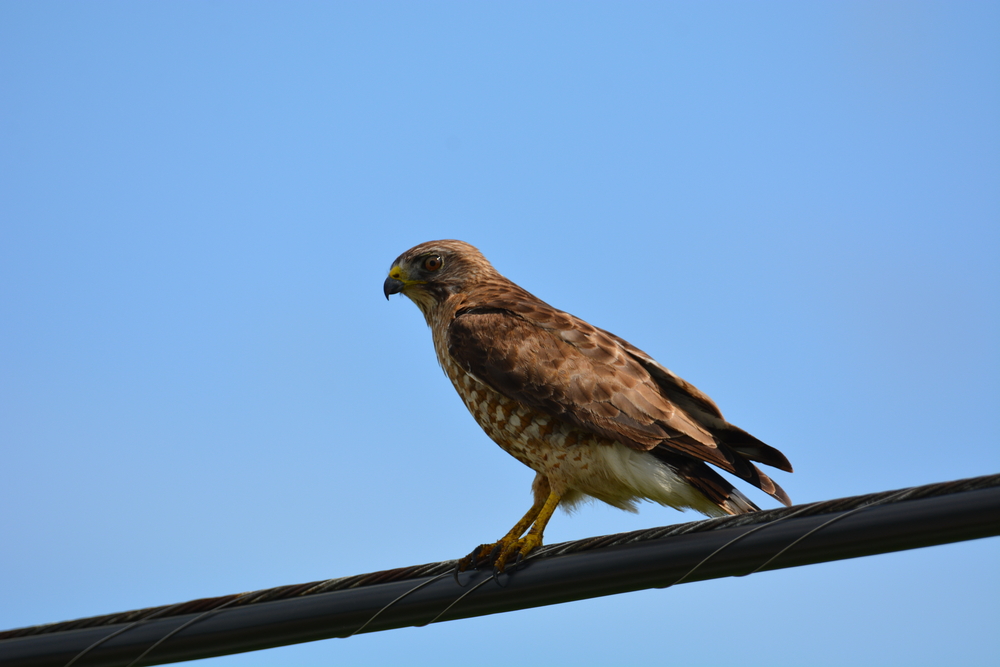
Coloration and Markings: Broad-winged Hawks have brown backs, with long, pointed, and broad brown wings which are brown on top and white bordered with brown underneath. They have short, squarish brown tails which are brown on top and have black and white banding on the underside as well. The belly of this bird is white with some minor rust streaking, which becomes more pronounced at the breast of this bird. These birds are somewhat grayish at the face, though the back and the top of the head are a mix of light brown and whites. These birds have short, stocky yellow bills which are curved and often black at the tips. Juveniles will be a lighter brown, with heavier streaking at the breast and thinner banding on the tail.
Size: These small Hawks measure in at 13.4 – 17.3 inches from tip to tail and have wingspans of 31.9 to 39.4 inches wide.
Habitat: These birds are found mostly in the deep woods, though during migration periods they may be spotted in large flocks in mountains or along coastlines.
Diet: Broad-winged Hawks eat a number of small reptiles, amphibians, and mammals. Examples include small turtles, mice, voles, toads, small birds, and they also enjoy large insects.
More about the Broad-winged Hawk
The Broad-winged Hawk is found in the Florida Panhandle during breeding season, though during migration they may be found in the central parts of the state and they winter in the southern tip of Florida. They have a lifespan of approximately 12 years, with the oldest known specimen to have attained an age of 18 years and 4 months. These birds have been in Florida for a long time. Fossil evidence of Broad-winged Haws actually goes back 400,000 years! The best time to watch for them is in the Fall, when they migrate to South America. Travelling an average of 4350 miles for this migration, they are hard to miss, travelling in large flocks called ‘Kettles’ which can contain thousands of birds. Keep an eye out in the fall and you can see for yourself, it’s an awe-inspiring sight!
Cooper’s Hawk – Accipiter cooperii
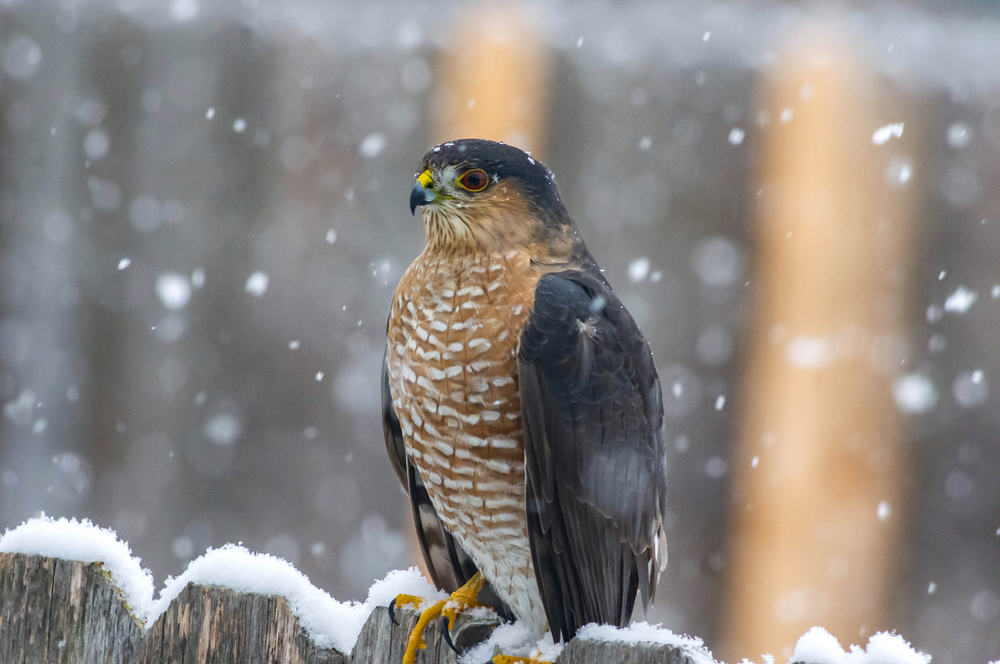
Coloration and Markings: Cooper’s Hawks have dark blue-gray backs with long, blue gray wings which have black and white bars on the underside with rust coloration towards the top center of the wings. They have long, blue-gray tails which have white and black lines on the underside and the belly and breast of this bird have rust-colored bars, with the barring thickest at the breast. Facially, these birds typically have a mix of rust and white for most of the face, with the exception of a thick black or blue-gray cap. These birds have short, stout, and hooked yellowish or black bills. Females will be about 2 inches longer in overall length than males and juveniles will have more of a brown coloration, rather than reds and grays.
Size: Male Coopers measure in at 16.5 – 17.7 inches in length with wingspans of 24.4 to 35.4 inches wide. Females average 16.5 – 17.7 inches in length and have wingspans of 29.5 to 3.4 inches.
Habitat: These bold birds prefer the deep woods but they do visit the city on occasion, even visiting backyards from time to time.
Diet: One of the reasons they like backyard with feeders in them is that these Hawks like to prey on medium-sized birds! They will also eat small mammals, reptiles, and insects, but their preferred fare is always smaller birds.
More about Cooper’s Hawk
Cooper’s Hawk is most often found in Southern Florida, where these birds like to winter, and they have a life expectancy of approximately 10 – 12 years. The longest-lived Cooper’s Hawk on record was a little over 20 years old but this is very rare for this bird. You can spot these birds sometimes at the forest’s edge and if you ever see them go after another bird, you’ll be both alarmed and amazed. These birds are extremely skillful flyers and the odds are that they will catch that bird and make a meal of it, with very few exceptions. Should one be attracted to your backyard, you can take your feeders down for a few days and the bird should go away. This will help to make sure that the Hawk doesn’t eat any of the other birds that like to visit your feeders regularly.
Golden Eagle – Aquila chrysaetos
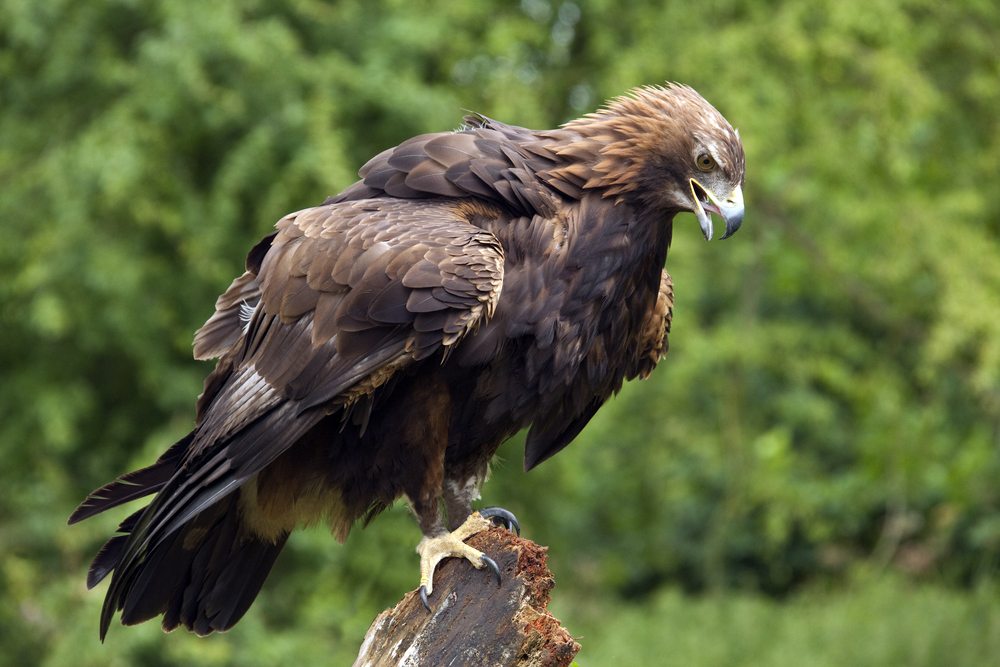
Coloration and Markings: Golden Eagles have dark brown backs, with long, dark brown wings and long tails, often with occasional patches of white on both. The underside of the tail will have some white and some golden coloration close to the rump and the belly and breast of this bird will be dark brown. Facially, this bird is brown, with a golden coloration at the back of the head and neck. These birds have stout, medium-length, hooked black and yellow bills.
Size: One of the largest birds in North America, Golden Eagles measure an impressive 27.6 – 33.1 inches from head to tail and have wingspans of 72.8 to 86.6 inches wide!
Habitat: While they may be found in a number of environments, such as desert, tundra, farmland, and coniferous woods, their favored locations for hunting are near mountains, cliffs, and hills.
Diet: These Eagles feed on medium-sized birds, such as the partridge or the grouse, but they also like medium-sized mammals as well. They aren’t limited to live prey, however, and are also quite fond of carrion when they find it.
More about the Golden Eagle
Most commonly spotted in the Florida Everglades, Golden Eagles are big and very, very tough, with a lifespan in the wild believed to be as high as 30 years! These apex predators are believed to be quite beneficial where livestock are concerned, as their tendency to eat up invading rabbits helps to ensure that there is more forage to go around. Golden Eagles are also the most common ‘official animal’ in the world, and their image has been adopted in the emblems of Albania, Germany, Kazakhstan, Austria, and Mexico.
Indeed, these birds of prey get a lot of respect, with electric companies working together since the 1970’s to create ‘eagle-proof’ poles to prevent accidental electrocution. Say what you will about the Golden Eagle, this is certainly one beloved bird and a sighting that you won’t soon forget!
Great Horned Owl – Bubo virginianus
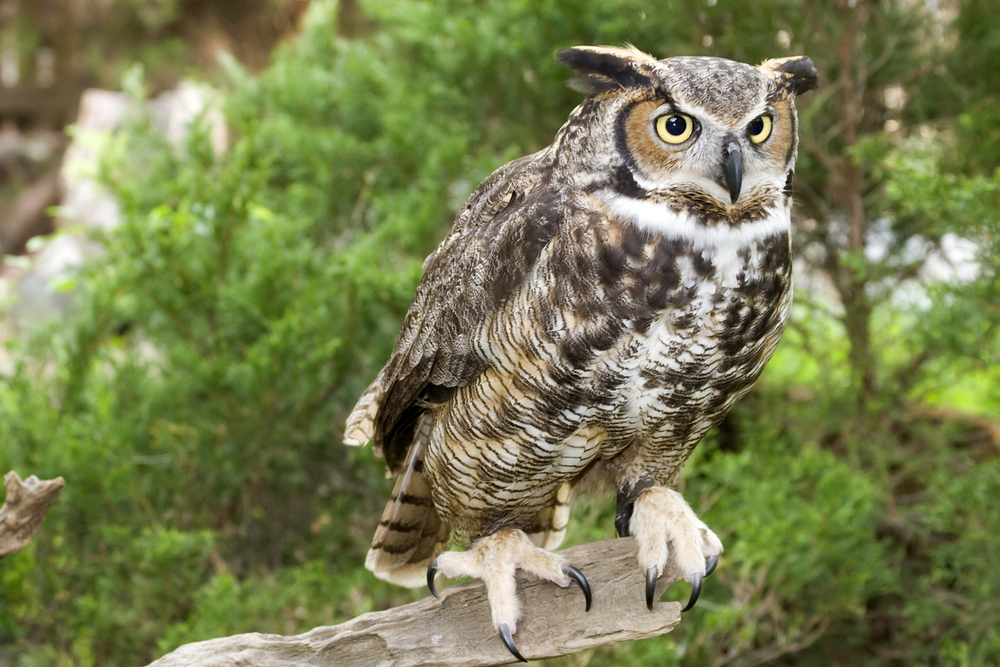
Coloration and Markings: The Great Horned Owl has a mottled gray and brown back with large, rounded wings and medium-length tails of the same color. The belly and breast of this bird are the same color, albeit slightly lighter, and you may see the occasional patch of foxy-brown present. They have a white patch at the throat and facially, these birds large very prominent ear-tufts and gray mottling coming down in a V-shape from the forehead to the bill, while they have a foxy brown coloration in half-circles around their yellow eyes which is outlined at the edges in dark gray or black. The birds have small, sharp, and curved black bills.
Size: These owls measure in at 18.1 – 24.8 inches in length and have wingspans of 39.8 to 57.1 inches wide.
Habitat: These birds love young, open woodlands, especially with lots of meadows or fields nearby for hunting. They may be found in a number of other environs, however, such as deciduous and evergreen forests, deserts, swamps, tundra, and even in the suburbs.
Diet: These predators will eat just about and small or medium sized animals that they can catch, dining on skunks, porcupines, squirrels, ducks, and even swans!
More about the Great Horned Owl
The Great Horned Owl may be found all over Florida and you can sometimes spot their nests, which are rather large and look to be haphazardly constructed. If you happen to know there is one in your neighborhood, you can put up a nesting box and you might just attract a breeding pair if you are lucky. Just be sure to install a guard on it to protect the eggs that these birds might lay.
These predators have notably strong talons, requiring 28 pounds of force to open once it’s got you in it’s grasp. As you can imagine, this means when they catch a critter it’s not likely to be going anywhere but in this owl’s belly. One spotting tip is to listen for Crows. Great Horned Owls like to eat these birds and so the clever Crows find safety in numbers, flocking together and taunting the Owl until it leaves the area for easier prey.
Limpkin – Aramus guarauna

Coloration and Markings: The Limpkin has a dark brown back with long, dark brown wings which sometimes have a minor speckling of white. They have short, squared brown tails and long, brown necks which have a heavy speckling of white. Facially, these birds are brown and white speckled, with dark brown caps and a white mustache line and a white eyebrow line. These birds have very long, yellow, and black-tipped bills, which are stout and have a slight curve.
Size: These birds measure in at 25 – 28.7 inches from tip to tail and have wingspans of 39.8 to 4.1 inches wide.
Habitat: While you might sometimes spot them in flood-prone fields, these birds spend most of their time in freshwater wetlands.
Diet: These birds have a very specialized diet, preying mostly on apple snails, for which their bills are quite adept at de-shelling. They also eat mussels, worms, and insects as well.
More about the Limpkin
Found in Florida wetlands, Limpkins have a lifespan of approximately 12 years and are birds of prey that hunt apple snails and mussels in shallow areas of freshwater. An interesting trait of this bird is a sickle-shaped, broad-tipped outer feather on each wing, that creates a bussing sound when this bird flies. This is thought to warn other Limpkins that a territory is taken. While it closely resembles a Rail or a Crane, the Limpkin is actually the only member of the family Aramidae.
Curiously enough, a number of researchers have reported that this bird has been seen ingesting rotting wood. Why they are doing this is uncertain, though it is likely a matter of either nutrients that they don’t normally get in their diet or possibly that the bacteria in the wood may aid in digestion.
Merlin – Falco columbarius

Coloration and Markings: Merlins have slate-gray backs, with long, slate gray wings which have black and white barring underneath, and medium-length tails which are slate-gray with white bands on the underside. The belly and breast of this bird are white with gray streaks and facially, these birds are white around the chin, cheeks, and throat. with a slate-gray mustache line, eyestripe, and cap. These birds have small, stout, and curved yellow and black bills. Females and juveniles will be brown, rather than gray, and will lack mustache lines.
Size: These birds measure in at 9.4 – 11.8 inches in length and have wingspans of 20.9 to 26.8 inches in width.
Habitat: These birds love open woods and grasslands, though you can also find them at the forest’s edge, especially if there is water nearby.
Diet: Sparrows, Swallows, Finches… 80% of their diet is smaller birds, but they do also eat lizards, snakes, small mammals, and larger insects.
More about the Merlin
Most commonly found in southern Florida, the swift Merlin has a lifespan of approximately 10 years and often hunt in pairs to bring down larger birds! These birds have a rich history, being the ‘bird of choice’ for European Noblewomen, including Mary Queen of Scots and Catherine the Great. Once known as the ‘pigeon hawk’ in North America, these birds are uncommonly fierce and will attack any other bird of prey which they see – including Eagles!
This reputation for fierceness is so well-established with smaller birds, that Banaquits which live in the Cayman Islands (where Merlins often winter) have been known to die of a heart attack when cornered by a hunting Merlin, before the bird can even sink his talons in. While larger birds will occasionally prey on them, it is rare, as larger carnivorous birds are often seen leaving when they spot a Merlin, perhaps deciding that the meal is not worth the work it’s going to take to get it.
Mississippi Kite – Ictinia mississippiensis

Coloration and Markings: Mississippi Kits are a mix of black and gray on their backs, with long, pointy gray wings which are white on the secondaries and long, squared tails which are black or dark gray on top and gray and white below, with black tips. The underside of the wings will be gray, but with white extending out on the middle portion on the upper underwing and the belly and breast of this bird will be white as well. Facially, these birds are white, with a broad, vertical black line in front of the eyes, and these birds have short, stout, and hooked yellow and black bills.
Size: These birds measure in at 13.4 – 14.6 inches in length and have wingspans approximately 3 inches wide.
Habitat: These birds love open prairie and hardwood forests, though you will also spot them occasionally in the suburbs.
Diet: Dragonflies, katydids, beetles, and other large insects make up most of this bird’s diet, though they do also eat the occasional bat, snake, mouse, or toad that happens to unluckily cross their paths.
More about the Mississippi Kite
While fairly rare, Mississippi Kites have been spotted at Lake Apopka Wildlife Drive, so keep an eye out if you live close. These birds have a lifespan of approximately 11 years and are quite territorial. They’ve been known to divebomb anyone that gets too close to their nests. Speaking of nests, the Mississippi Kite often builds a nest close to a wasp’s nest, and this is believed to protect their chicks from other predators.
They even have the occasional ‘nest guards’. 1-year old Mississippi Kites will sometimes join a breeding pair and help to incubate the eggs, brood the chicks, and to defend the nest. While the pair will sometimes chase the 1-year old away, they generally accept the offered help.
Osprey – Pandion haliaetus

Coloration and Markings: Ospreys have dark brown backs, with long, thin dark brown wings which are white on the underside with the exception of a dark wrist-patch. They have long, thin brown tails which are white with dark tips underneath and the belly and breast of this bird are paper-white. Facially, these birds have white faces, with a thick, brown eyeline that widens as it reaches the back of the head and a thin brown cap is often present towards the top-middle of the head. These birds have stout, medium-length, and hooked black bills. Juveniles will display some white spots in their brown plumage and some tan coloration at the breast.
Size: These birds measure in at 21.3 – 22.8 inches and have wingspans of 59.1 to 70.9 inches wide.
Habitat: Osprey nests are easy to spot, as they are often stuck right on top of poles! These birds may be found near fresh or saltwater, where they like to do their hunting.
Diet: Ospreys feed primarily on fish.
More about the Osprey
Also known as the Sea Hawk, the Osprey has an average lifespan of 7 – 10 years, though some specimens have lived to be 20 – 25 years old! The ‘Sea Hawk’ title is very apt, as these birds feed primarily on fish which they catch by diving feet-first into the waters to grab fish with their talons. Sometimes they dive hard enough to become fully submerged, but they almost always pop right back up with a wriggling fish in their talons.
These birds have one an uncommon trait in the form of a reversible outer-toe, which means that they can grasp fish with a steely grip consisting of 2 toes in front and 2 behind. They even align their prey so that they are facing head-first for less wind resistance when they are flying their meals home!
Peregrine Falcon – Falco peregrinus
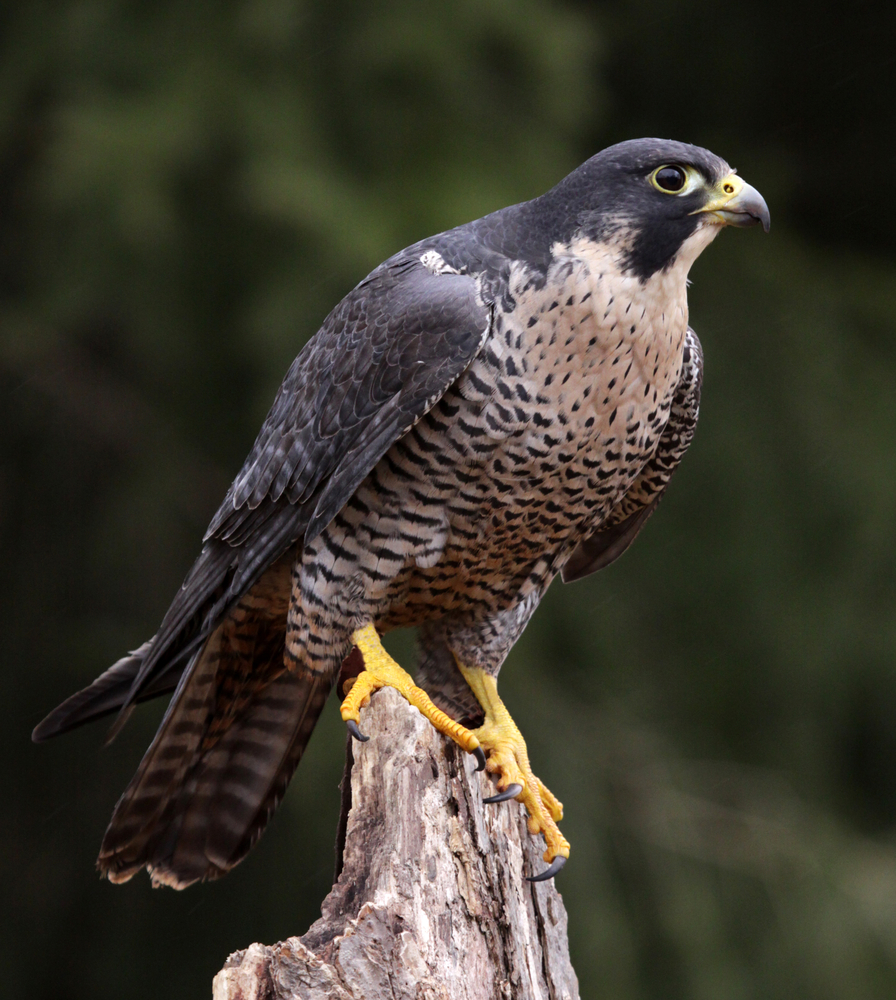
Coloration and Markings: Peregrine Falcons have blue-gray backs, with long wings and tails of the same color until you see them in flight. The undersides of the wings and tail have a beautiful vertical barring pattern of gray on white. On the tail, it is complimented with black tips, and the belly and the breast also display this lovely barring across them as well. Facially, these birds have white chins and throats, but the remainder of the face is blue-gray. These birds have stout, medium-length, and hooked yellow and gray bills.
Size: These birds measure in at 14.2 – 19.3 inches in length and have wingspans of 39.4 to 43.3 inches wide.
Habitat: These birds nest in high places, such as cliffs, skyscrapers, and even power arrays. If you see a bunch of ducks suddenly erupting into the sky, look for a Peregrine as it is likely hunting nearby.
Diet: Ducks, gulls, pigeons, songbirds, and sometimes the occasional bat make a meal for the Peregrine Falcon. They have been known to steal fish from other birds as well.
More about the Peregrine Falcon
The Peregrine Falcon may be found all over Florida and you should look for them in the fall. While they sometimes live a little longer, the average lifespan of a Peregrine is approximately 15 years. One of the most popular birds for Falconry, Peregrines are very swift in their flights, with an average travel speed of 25 – 34 miles per hour that can increase to 69 mph when they have spotted some prey that they’ve decide might be tasty. Their diving is even faster, and a hunting Peregrine that dives on its prey can reach amazing speeds as high as 186 miles per hour!
It’s obviously an efficient design and due to this, you can find Peregrine Falcons on any continent in the world, with the exception of Antarctica and a handful of islands.
Red-tailed Hawk – Buteo jamaicensis
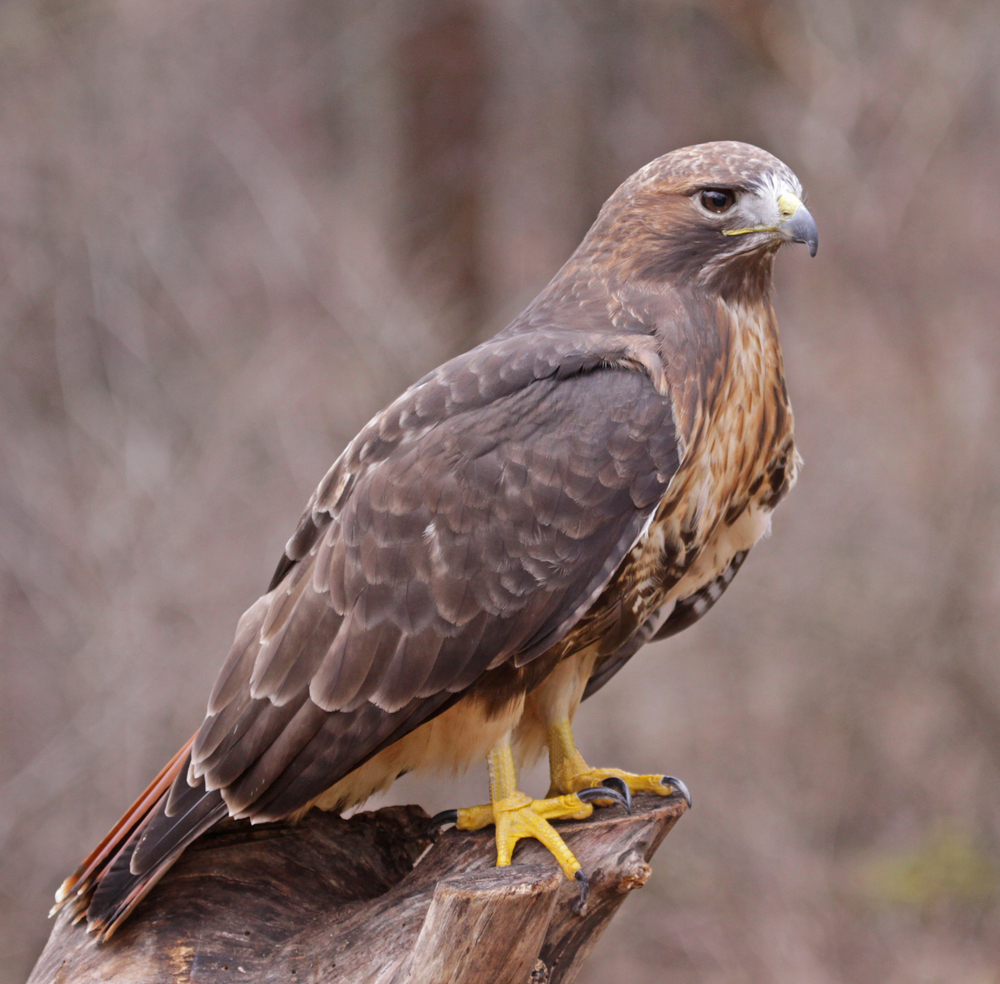
Coloration and Markings: Red-tailed Hawks have backs and rounded wings which are a mix of grays and browns on top, though below the wings are white with a dark bar from shoulder to wrist. Their tails are a rusty red color above and below, though the color on the underside is fainter. The belly and breast of this bird are white with traces of red and some dark lines are often present crossing the breast. Facially, there may be variance, as plumage can vary widely in this species. Commonly you will see a white face with a thick, brown and gray eyestripe or you might even see a dark brown and gray covering the face completely. These birds have short, stout, and hooked black bills.
Size: Male Red Tails average 17.7 – 22.1 inches in length, while females are slightly larger at 19.7 to 25.6 inches. Both have wingspans of approximately 44.9 – 52.4 inches wide.
Habitat: These birds love open areas, especially fields, where they perch somewhere high and ready themselves to swoop down to capture their prey.
Diet: These Hawks like rabbits, squirrels, and snakes, though they also snack on the occasional bat, toad, or even carrion, if the hunting is poor that week.
More about the Red-tailed Hawk
When you hear a Hawk in a movie, you are hearing the distinctive call of the Red-tailed Hawk. While it’s a horrifying sound for rabbits, Hollywood decided that it’s the perfect Hawk-screech for us and so they use it for any kind of Hawk that you see on the big screen. It’s hard to blame them, as it certainly gets your attention.
If you happen to spot one during mating season then you are in for a treat. Males start by circling around, then diving and rising back up at similar, seemingly-impossible angles, before diving down to touch a female lightly to get her attention. Sometimes the female responds an they will clasp talons, falling together in a slow, dizzying spin, separating again before the fall can become deadly!
Red-shouldered Hawk – Buteo lineatus
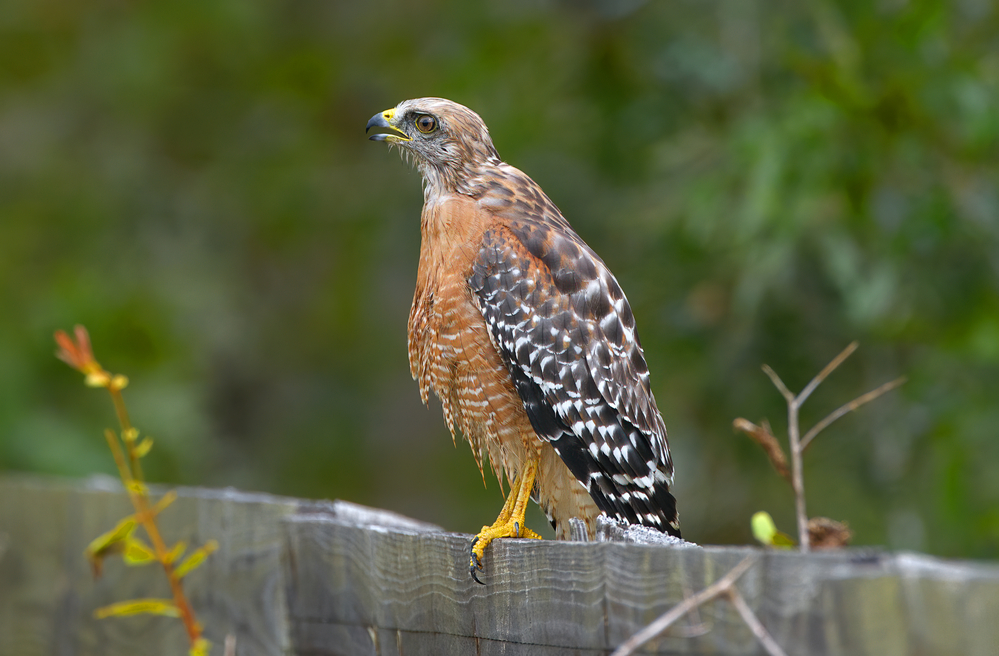
Coloration and Markings: Red-shouldered Hawks have beautiful plumage, with their red shoulders and their backs and long, rounded wings a mix of blacks and whites mottled together. Their tails are medium-length and also have the black and white patterning on top, though when seen from below the wings and tails are a little different. For the wings, vertical black barring is present throughout with the exception of the area from the shoulders to the wrists, which is a light, rusty red. The underside of the tail has rusty red lines across a background of white. The belly and breast of this bird are rusty-red with some small amount of white present and facially, their heads are mostly red with gray in front of the eyes and cheeks and on the chin. These birds have small, but stout hooked bills which are yellow and black-tipped.
Size: These birds measure in at 16.9 – 24 inches in length and have wingspans of 37 to 43.7 inches in width.
Habitat: These birds prefer deciduous woodlands, especially if there is water nearby. You can sometimes spot them along the coast during migration periods as well.
Diet: These birds eat a wide variety of foods, such as chipmunks, voles, snakes, frogs, and crayfish. They eat fish as well, but this is less common.
More about the Red-shouldered Hawk
Common to Southern Florida, the Red-shouldered Hawk has a lifespan of approximately 15 to 19 years in the wild. These birds have long courtship rituals, lasting around 18 days, and if you spot a male and a slightly larger female circling together then you are likely witnessing one. You’ll probably hear it first, however, as this bird likes to announce it’s courting to the world.
These birds are monogamous and actually work together when building their nest, a process which 1 -5 weeks and these birds will typically try to nest in the same place the next year, refreshing their old nest with new conifer sprigs, lichen, and moss.
Sharp-shinned Hawk – Accipiter striatus

Coloration and Markings: Sharp-shinned Hawks are blue and gray on their backs, the tops of their short, rounded wings, and the tops of their long, square-tipped tails. On the underside, the wings are a mix of reddish-orange with black barring while the tails display reddish-orange with much more spaced barring, looking almost like lines. The underbelly and breast of this bird are reddish-orange bars with some white present, though on occasion you will see some darker barring mixed in as well. Facially, these birds are white and reddish orange from chin to cheeks, while the remaining upper portions of the head are bluish-gray. These birds have short, hooked black bills.
Size: Male Sharp-shinned Hawks are the smallest hawks in North America, measuring in at a mere 9.4 – 13.4 inches in length and with wingspans of 16.9 to 22.1 inches wide.
Habitat: These birds like the deep forest, though you can occasionally see them hunting at the forest’s edge or even the occasional backyard, where they might eat your visiting songbirds! During migration periods you can also see them on ridgelines or flying across open fields or parks.
Diet: These birds will eat large insects and small mammals but their favorite food is smaller birds.
More about the Sharp-shinned Hawk
During fall, winter, and spring you can find the Sharp-shinned Hawk all over Florida, with the exception of the keys. These birds are relatively short-lived, with a lifespan averaging only 5 years, though the oldest recorded Sharp-shinned Hawk was recorded to have lived for 12 years and 2 months.
After catching a small bird, these Hawks don’t simply gobble them down, but will carry them to a stump so that they may pluck out the feathers first. Their talons are also quite amazing for hunting, as they are much like a cat’s claws and actually impale the bird’s prey to produce a deadly, steel grip.
Short-tailed Hawk – Buteo brachyurus
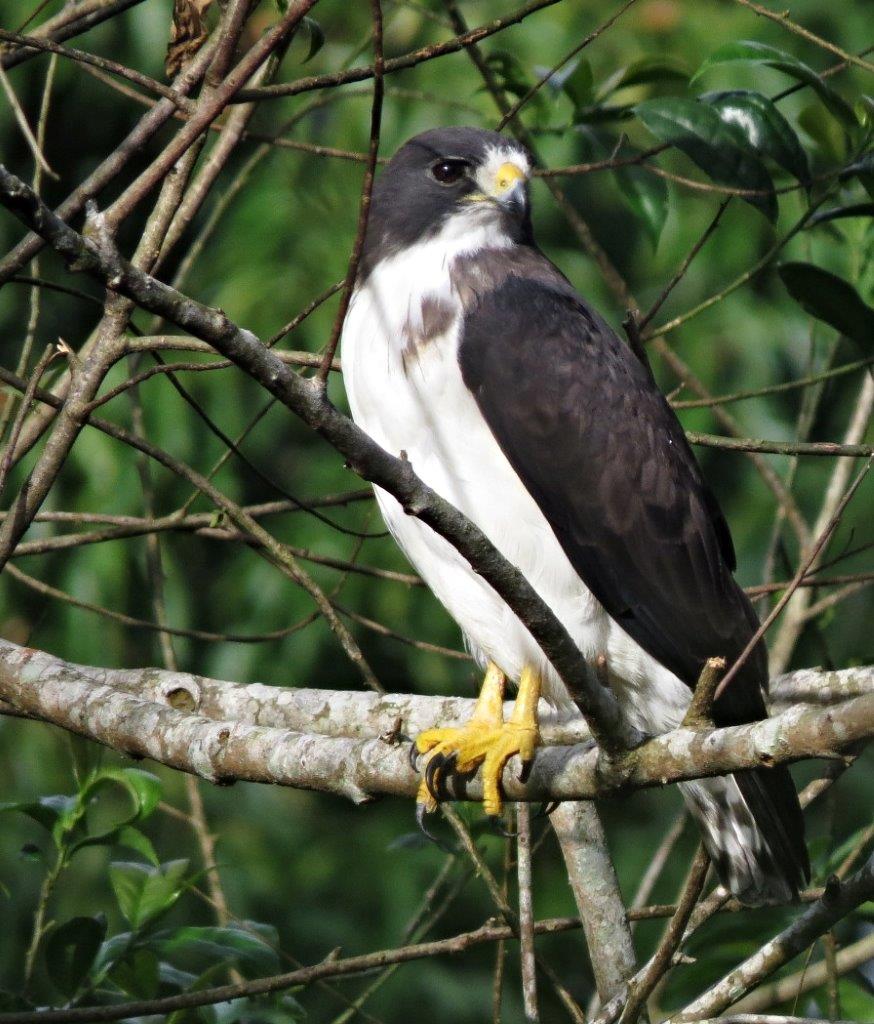
Coloration and Markings: Short-Tailed Hawks are have dark brown backs, with long, dark brown wings and short, brown tails. When viewed in flight, the undersides of the wings are pale, almost white on the inner-lining feathers, and the tails have noticeable brown and white banding. The belly and breast of this bird are white (sometimes brown, but morphs occur commonly with this species) and facially, these birds have white throats and chins, while the remainder if this face will be dark brown. These birds have large, but short and hooked silver bills.
Size: These birds measure an average of 14 inches in length and have wingspans of approximately 35 inches wide.
Habitat: These hawks love pine forests, swamps, mangroves, and the forest’s edge when there is an open area for hunting nearby.
Diet: These birds eat smaller birds, ranging from tiny songbirds to birds about the size of the Mourning Dove. They eat the occasional Sharp-shinned Hawk, as well, and supplement their diets with rodents, snakes, and lizards when the other birds are hiding.
More about the Short-tailed Hawk
Though rare, these tropical Hawks do sometimes appear in Central Florida (and this is the only place that you’ll find them in the United States!) and we don’t actually know their lifespan. We do know that these migratory birds have been found in Florida, Mexico, Costa Rica, and even Amazonian Peru!
Though called a Hawk, this bird is actually considered a ‘buzzard’ and it’s call sounds a lot like other buzzards should you hear it. The Short-tailed Hawks that you can see in Florida are almost always dark brown to almost black and the way it attacks it’s prey is quite interesting. This bird uses a technique known as ‘kiting’, where it flies against the wind, achieving a high elevation, where it may either dive down vertically to capture its prey or proceed in a series of small dives as is taking stair-steps! It’s a sight to behold and we hope that sometime you get to see it in person!
Snail Kite – Rostrhamus sociabilis

Coloration and Markings: Snail Kites have dark gray backs with long, broad gray wings and long, broad black tails, which are white at the base on both sides, as well as on the tip. The belly of this bird is white, while the breast is dark gray and facially, this bird is dark gray as well. These birds have thin, medium-length hooked bills which are typically orange with black tips.
Size: These birds measure in at 12.2 – 15.3 inches in length and have wingspans of 4.9 to 45.7 inches wide.
Habitat: These birds forage and nest in the Southern Florida wetlands.
Diet: These birds are highly specialized, feeding themselves on a diet almost exclusively consisting of apple snails.
More about the Snail Kite
Snail Kites get their name for the main component of their diet. Their curved beaks are specially adept at removing Florida Apple Snails from their shells, though when snails are scare these birds will eat the occasional turtle, crayfish, or rodent to fill their bellies. These birds have a life expectancy of approximately 9 years and the males are good to their mates, providing nesting material as part of their courtship ritual.
That isn’t to say that they are monogamous, however, because if food is plentiful enough then the male or the female might sneak out in order to produce more offspring. While their ‘official’ mating season is February to July, this species can and does mate at any time that they feel like it.
Swallow-Tailed Kite – Elanoides forficatus

Coloration and Markings: Swallow Kites are skinny, sharp-looking raptors. These birds have black backs, with long, pointed black wings, often with white patches on the lower half and which are white on the inner lining when viewed in fligth. They also have long, forked black tails. The belly and breast of this bird are a snowy white, as is the face, and these birds have short, stout, and hooked bills which are typically yellow or yellow and gray.
Size: These birds measure in at 19.7 – 25.2 inches from tip to tail and have wingspans of approximately 48 inches wide.
Habitat: These birds may be found near rivers or in swamps or marshes.
Diet: These birds like to hunt for snakes, lizards, toads, and large insects. Though primarily carnivorous, Swallow-tailed Kites have been observed snacking on fruit in the wild as well.
More about the Swallow-tailed Kite
The Swallow-tailed Kite is a popular bird in Florida, as these birds arrive in droves from South America to spend their summers in South and Southeastern Florida every year. Before they leave, these birds must store 20 – 40% of their weight as fat to prepare for the long flight back to the Andes in South America.
Despite being such hardy travelers, these birds have a relatively short lifespan of 6 years. If you see one out and about and you’re lucky, you might get to see the bird taking a drink. This is not done by simply standing at the waterside, but rather the Kite will fly close enough to the water to skim it, scooping up a drink!
White-tailed Kite – Elanus leucurus

Coloration and Markings: White-tailed Kites have bluish-gray backs, with pointed wings which are black at the shoulders but bluish-gray for the remainder of their length when viewed from above. When seen in flight, their wings are mostly white, with 1/3 of the wing close to the tips being shaded a dark gray to black. They have long, white tails, and the belly and rbeast of this bird are a snow white as well. Facially, this bird has a white head, and if it is close, you’ll see that it has red eyes as well. These birds have short, hooked yellow and black-tipped bills.
Size: These birds measure in at 12.6 – 15 inches in length and have wingspans of 39 to 43.3 inches in width.
Habitat: These birds love open woodlands, fields, and marshes.
Diet: White-tailed Kites feed on small mammals, such as gophers, voles, squirrels, mice, and rabbits. They will occasionally eat smaller birds, lizards, and large insects as well.
More about the White-tailed Kite
Found in South Central and Southeastern Florida, the White-tailed Kite earns its name for the ability to ‘float’ or hover in the air without beating it’s wings, which is known as ‘kiting’. They have a fairly short life expectancy of approximately 6 years and are fairly communal, sometimes flocking in groups of close to 100, until breeding season arrives. At this time, these birds become quite territorial, and their combat tactics involved locking talons in mid-air as they fight to establish their domains.
During breeding season there is another amazing courtship ritual which you might see, where a male offers a female a freshly captured kill, which she receives by flying underneath the male, turning upside-down, and accepting in mid-flight!
In conclusion
We hope that you’ve enjoyed our little exploration into the Florida Birds of Prey. Be sure to keep an eye out for these birds when you are spending a little time out of the house and should one become a backyard nuisance or danger to your other birds, just remember that you can simply remove your feeders for a couple of days and they should go away. Just be sure to get a photo or two first!
